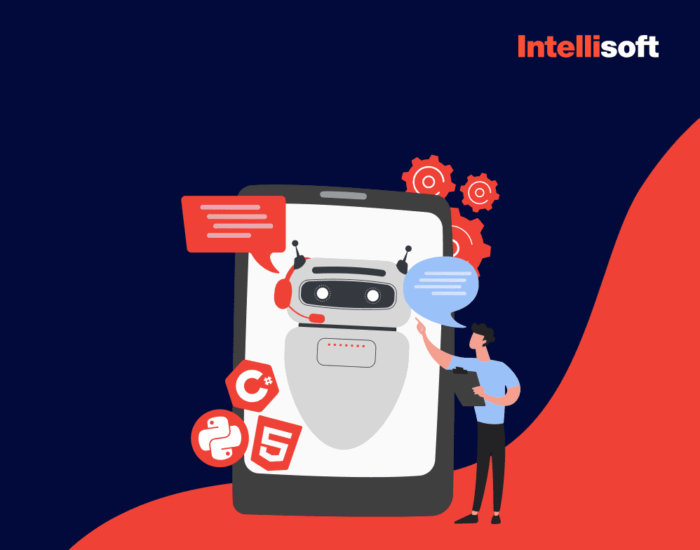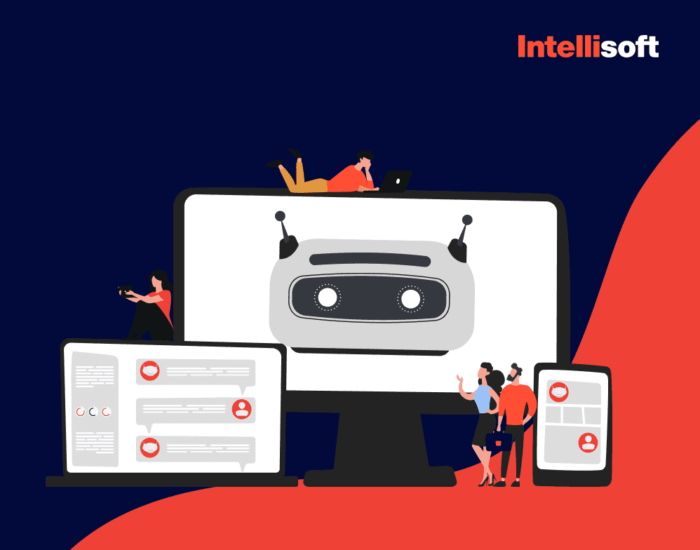Clients’ testimonials
Our Flutter App Development Services
Download our portfolio with previous projects
The best proof of our work is the portfolio with our past projects. You can see what IntelliSoft’s clients think about our cooperation. Check out projects for various industries.

Advantages of Using Flutter in Your Tech Stack
Cost-Effectiveness
Industries we serve
Reasons To Hire IntelliSoft For Flutter App Development
IntelliSoft Process For Flutter App Development
Related Services
Frequently Asked Questions (FAQ)
Flutter is a mobile application development framework created by Google that allows developers to build high-performance, cross-platform applications for both Android and iOS. Flutter development services refer to those provided by developers specializing in building applications using Flutter.
Flutter development services include everything from creating UI/UX designs, developing backend systems, integrating APIs, testing, deployment, and ongoing maintenance and support of the application. Some of the critical features of Flutter that make it popular among developers include its fast development time, hot reload feature, customizable widgets, and reactive programming.
You can use Flutter development services to build various applications such as e-commerce, social media, gaming, healthcare, and more. Businesses can hire Flutter developers or outsource their projects to a Flutter development company to create high-quality, cross-platform mobile applications to help them reach a wider audience and drive growth.
The cost of hiring a Flutter developer can vary depending on several factors, including their experience level, location, and the project’s complexity.
Generally, the hourly rate of a Flutter developer can range from $30 to $200 per hour, depending on their experience and expertise. Freelance Flutter developers may charge lower rates, while Flutter development companies may have higher rates due to the additional overhead costs of running a business.
Another factor affecting the cost of hiring a Flutter developer is their location. Developers in regions with higher living costs and wages may charge more than those in areas with lower costs of living.
Additionally, the project’s complexity can affect the cost of hiring a Flutter developer. More complex projects may require more experienced developers, which can increase the hourly rate.
It’s essential to remember that the cost of hiring a Flutter developer should not be the only factor considered. Evaluating the developer’s experience, portfolio, and communication skills is crucial to ensure they can deliver a high-quality product that meets your business needs.
Depending on your preferences and requirements, you can use several platforms for Flutter development. Here are some popular options:
- Android Studio: This is the official IDE for Android development and includes support for Flutter. It offers a range of features, such as code completion, debugging, and testing tools. Thus, use Flutter for Android applications.
- Visual Studio Code: This lightweight and popular code editor is free and open-source. It has many extensions that support Flutter development, making it a popular choice among developers.
- IntelliJ IDEA: This is a Java-based IDE developed by JetBrains, and it has excellent support for Flutter development. It offers features such as code completion, debugging, and testing tools.
- Xcode: This is the official IDE for iOS development and includes support for Flutter. It offers a range of features, such as code completion, debugging, and testing tools.
Ultimately, the best platform for Flutter development depends on your preference and project requirements. All of these options have their strengths and weaknesses, so choosing the one that works best for you is essential.
Flutter can be an excellent choice for MVP (Minimum Viable Product) development. Flutter offers several advantages that make it well-suited for developing MVPs:
- Fast development time: Flutter’s “hot reload” feature allows developers to make changes to the code and see the results instantly, speeding up the development process and making it easier to iterate on the product.
- Cross-platform support: Flutter allows you to write code once and deploy it on both iOS and Android platforms, saving time and resources compared to developing separate apps for each platform.
- Beautiful UI: Flutter offers a rich set of pre-built widgets and allows custom widgets to be created, making it easier to create a visually appealing and user-friendly UI for your MVP.
- Strong performance: Flutter’s architecture and design allow for fast and smooth Flutter performance, which can be critical for an MVP that needs to impress potential users and investors quickly.
Overall, Flutter can be an excellent choice for MVP development if you must quickly develop a cross-platform app with a beautiful UI and strong performance.
Flutter is a popular and powerful mobile app development framework that offers several benefits. The benefits of Flutter programming language are the following:
- Fast development time: Flutter’s “hot reload” feature allows developers to make changes to the code and see the results instantly, speeding up the development process and making it easier to iterate on the product.
- Cross-platform support: Flutter allows you to write code once and deploy it on both iOS and Android platforms, saving time and resources compared to developing separate apps for each platform.
- Beautiful UI: Flutter offers a rich set of pre-built widgets and allows custom widgets to be created, making it easier to create a visually appealing and user-friendly UI for your app.
- Strong performance: Flutter’s architecture and design allow for fast and smooth app performance, which can be critical for delivering a high-quality user experience.
- Easy to learn: Flutter uses the Dart programming language, which is easy to learn and has a clean syntax, making it accessible to developers of all levels.
- Open-source community: Flutter has a large and active community of developers who contribute to the development of the framework, create plugins, and offer support through forums and online communities.
- Flexibility: Flutter allows for customization and flexibility in designing and developing your app, giving you control over how your app looks and behaves.
Overall, Flutter offers many benefits, making it an excellent choice for quickly and efficiently developing high-quality Flutter mobile apps.
The time it takes to develop a Flutter app can vary depending on several factors, such as the app’s complexity, the features and functionalities required, the size of the development team, the level of experience of the developers, and the development process used.
However, as a general guideline, developing a basic Flutter app with a few simple features can take anywhere from a few days to a few weeks. Creating a more complex Flutter app with advanced features and functionalities can take several weeks or months.
It’s important to note that development time is not the only factor when building a Flutter app. Other factors, such as testing, debugging, and deployment, can also take time and should be factored into the project timeline. Additionally, ongoing maintenance and updates may be required after launching the app, which can add to the development time and cost.
You can use several tools to monitor your developers’ progress during the development of a Flutter app. Here are a few options:
- Project management software: You can use tools like Trello, Asana, or Jira to create tasks, set deadlines, and track progress. These tools allow you to assign tasks to specific developers, track their progress, and communicate with them directly through the platform.
- Code repository hosting services: Code repository hosting services like GitHub and Bitbucket allowing you to track development progress by monitoring commits and pull requests. You can also use these platforms to provide feedback and collaborate with the developers directly.
- Time tracking tools: Tools like Toggl or Harvest allow you to monitor how much time each developer spends on specific tasks. Those tools can help you identify bottlenecks or areas with more resources.
- Daily or weekly stand-up meetings: You can schedule daily or weekly meetings with your development team to discuss progress, identify any roadblocks, and provide feedback. This way, you can ensure everyone is on the same page and working towards the same goals.
It’s essential to choose the right tool(s) that work for your team and project and to use them consistently to track progress and identify any areas where improvements can be made.
Flutter developers use version control systems (VCS) such as Git to manage their codebase. VCS allows developers to track changes to their code, collaborate with other team members, and roll back to previous versions of their code if needed.
Developers also use IDEs (Integrated Development Environment) such as Android Studio or Visual Studio Code, which provide tools to facilitate the development and management of Flutter code. These IDEs include code completion, syntax highlighting, and debugging tools to help developers write and manage their code more efficiently.
Additionally, developers can use packages and plugins from the Flutter community to add functionality to their applications. The Flutter community offers many packages and plugins to help developers save time and effort while building their applications.
Finally, Flutter developers can use various tools for automated testing and continuous integration and deployment (CI/CD). These tools help developers ensure the quality of their code and streamline the deployment process.
While Flutter has many advantages, there are also some disadvantages to consider:
- Limited library support: Flutter’s library support is relatively limited compared to other more established frameworks. Although Flutter has a rapidly growing community and many applicable packages, it may not yet have all the libraries that some developers need.
- Large app size: Flutter apps can have larger file sizes than native apps, making them slower to download and taking up more space on the user’s device. However, there are ways to mitigate this issue, such as code splitting and compression techniques.
- Steep learning curve: Although Flutter is relatively easy for developers with experience in object-oriented programming languages, it may still have a steep learning curve for those new to programming or the Dart language.
- Limited support for older devices: Flutter apps may not work on older devices or operating systems, which can limit their potential audience. However, this is a common issue with most new technologies. Flutter developers can use tools like the Flutter doctor to identify compatibility issues and ensure their apps run smoothly on different devices.
- Limited support for some native features: While Flutter offers access to many native features, such as camera and GPS, some features may not yet be available or require additional work to implement. However, the Flutter community continually works to improve the framework, and many features are already available through third-party packages.
Overall, while there are some disadvantages to using Flutter, many developers find that its advantages outweigh these issues and choose to use it for their app development needs.
- Flutter has a growing ecosystem of tools and packages, making developing Flutter applications more accessible and efficient. Here are some of the most popular Flutter tools:
- Flutter SDK: The Flutter SDK is essential for developing Flutter applications. It includes everything you need to start with Flutter, including the Flutter framework, a suite of pre-built widgets, and a command-line tool for creating and managing projects.
- Android Studio / IntelliJ IDEA: Android Studio and IntelliJ IDEA are popular integrated development environments (IDEs) supporting Flutter development. They provide features like code completion, debugging, and testing and have built-in support for Flutter.
- Visual Studio Code: Visual Studio Code is another popular IDE that supports Flutter development. It provides many of the same features as Android Studio and IntelliJ IDEA but is a more lightweight option that some developers may prefer.
DartPad: DartPad is an online code editor that allows you to write and run Dart code in your browser. It’s a great way to prototype ideas quickly and try out new features without setting up a full development environment. - Flutter DevTools: Flutter DevTools is a suite of tools that helps you debug and analyze your Flutter applications. It includes a widget inspector, performance profiler, and network inspector, among other devices.
- FlutterFire: FlutterFire is a collection of pre-built Firebase plugins that make adding Firebase functionality to your Flutter applications easy. It includes plugins for features like authentication, cloud storage, and real-time databases.
- Flutter Packages: Flutter Packages is a website that hosts thousands of packages created by the Flutter community. These packages provide functionality like animations, charts, and maps, saving time and effort when building your Flutter applications.






